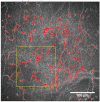Neuroinflammatory Findings of Corneal Confocal Microscopy in Long COVID-19 Patients, 2 Years after Acute SARS-CoV-2 Infection
- PMID: 37892009
- PMCID: PMC10605628
- DOI: 10.3390/diagnostics13203188
Neuroinflammatory Findings of Corneal Confocal Microscopy in Long COVID-19 Patients, 2 Years after Acute SARS-CoV-2 Infection
Abstract
Objective: To describe corneal confocal microscopy findings in patients with long COVID-19 with persistent symptoms over 20 months after SARS-CoV-2 infection.
Design: A descriptive cross-sectional study that included a total of 88 patients; 60 patients with Long COVID-19 and 28 controls. Long COVID-19 diagnosis was established according to the World Health Organization criteria. Corneal confocal microscopy using a Heidelberg Retina Tomograph II (Heidelberg Engineering, Heidelberg, Germany) was performed to evaluate sub-basal nerve plexus morphology (corneal nerve fiber density, nerve fiber length, nerve branch density, nerve fiber total branch density, nerve fiber area, and nerve fiber width). Dendritic cell density and area, along with microneuromas and other morphological changes of the nerve fibers were recorded.
Results: Long COVID-19 patients presented with reduced corneal nerve density and branch density as well as shorter corneal nerves compared to the control group. Additionally, Long COVID-19 patients showed an increased density of dendritic cells also with a greater area than that found in the control group of patients without systemic diseases. Microneuromas were detected in 15% of Long COVID-19 patients.
Conclusions: Long COVID-19 patients exhibited altered corneal nerve parameters and increased DC density over 20 months after acute SARS-CoV-2 infection. These findings are consistent with a neuroinflammatory condition hypothesized to be present in patients with Long COVID-19, highlighting the potential role of corneal confocal microscopy as a promising noninvasive technique for the study of patients with Long COVID-19.
Keywords: COVID-19; Long-COVID; corneal confocal microscopy; corneal nerve plexus; dendritic cells.
Conflict of interest statement
All The authors declare no conflict of interest.
Figures




Similar articles
-
Corneal Cellular and Neuroinflammatory Changes After SARS-CoV-2 Infection.Cornea. 2022 Jul 1;41(7):879-885. doi: 10.1097/ICO.0000000000003018. Epub 2022 Mar 17. Cornea. 2022. PMID: 35349500
-
Corneal nerve fiber morphology following COVID-19 infection in vaccinated and non-vaccinated population.Sci Rep. 2024 Jul 22;14(1):16801. doi: 10.1038/s41598-024-67967-x. Sci Rep. 2024. PMID: 39039160 Free PMC article.
-
Corneal confocal microscopy identifies corneal nerve fibre loss and increased dendritic cells in patients with long COVID.Br J Ophthalmol. 2022 Dec;106(12):1635-1641. doi: 10.1136/bjophthalmol-2021-319450. Epub 2021 Jul 26. Br J Ophthalmol. 2022. PMID: 34312122 Free PMC article.
-
Corneal nerves in diabetes-The role of the in vivo corneal confocal microscopy of the subbasal nerve plexus in the assessment of peripheral small fiber neuropathy.Surv Ophthalmol. 2021 May-Jun;66(3):493-513. doi: 10.1016/j.survophthal.2020.09.003. Epub 2020 Sep 19. Surv Ophthalmol. 2021. PMID: 32961210 Review.
-
Corneal Sub-Basal Nerve Plexus in Non-Diabetic Small Fiber Polyneuropathies and the Diagnostic Role of In Vivo Corneal Confocal Microscopy.J Clin Med. 2023 Jan 13;12(2):664. doi: 10.3390/jcm12020664. J Clin Med. 2023. PMID: 36675593 Free PMC article. Review.
References
-
- Delbressine J.M., Machado F.V.C., Goërtz Y.M.J., Van Herck M., Meys R., Houben-Wilke S., Burtin C., Franssen F.M.E., Spies Y., Vijlbrief H., et al. The Impact of Post-COVID-19 Syndrome on Self-Reported Physical Activity. Int. J. Environ. Res. Public Health. 2021;18:6017. doi: 10.3390/ijerph18116017. - DOI - PMC - PubMed
LinkOut - more resources
Full Text Sources
Miscellaneous

